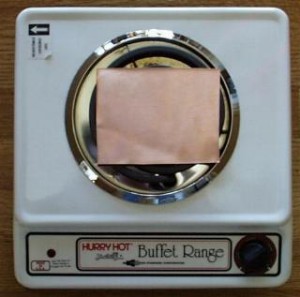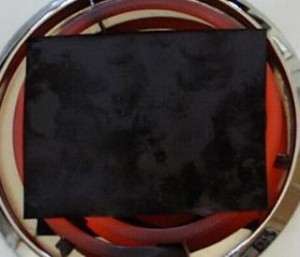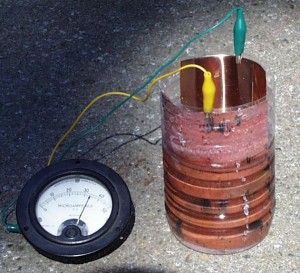A solar cell or a photovoltaic cell is a device that converts solar energy into electrical energy. This is known as the photovoltaic effect. Since the energy source of this cell comes from the sun, certain characteristics like the voltage, current and the resistance may vary. It will depend on the strength of the sun’s rays that are filtered by the earth’s atmosphere.
This article will discuss how you can create your own solar cell in your kitchen.
What you will need:
- 1 sheet of copper flashing (½ square foot)
- 2 alligator clip leads
- Micro-ammeter (the sensitive kind that can read 10 to 50 microamperes)
- Electric stove
- 1 pcs 2 liter plastic water bottle
- Table salt
- Tap water
- Sand paper
- Shears for cutting metal sheets
What you need to do:
- Cut the copper sheet to be the same size as the burner of the electric stove. Wash the copper sheet with soap to make sure it does not have any grease on it.

- Sand the copper sheet using the sandpaper to clean it thoroughly. You want to remove the sulphide and the other corrosion on the sheet. Dry it off.
- Put it on top of the burner and put the stove to the highest setting. Observe how the copper will heat up and show different oxidation patterns (orange, purple and red).These are the cuprous oxide layer. The copper is really hot when it is replaced by a black coating – which is the cupric oxide. This black coating will flake off later.
- When the burner is glowing red and the copper sheet is coated with black, let it stay there for the next 30 minutes. You want the cupric oxide to get thicker so it can flake off easily and nicely later on. That should leave a thin coat that will stick to the copper.

- Turn off the burner after 30 minutes and leave the copper sheet to cool slowly. Do not cool it quickly as to prevent the black oxide from staying stuck to the copper. While cooling, the copper will shrink and the same is true for the black cupric oxide. Since the two will shrink at varying rates, the black coating will tend to flake off.
- The cooling process (up to room temperature) will take about 20 minutes. While that is happening, the black flakes will pop off the copper.
- Clean off the remaining black coating after 20 minutes by placing the copper sheet under running water and lightly scrub the surface with your hands. Do not scrub the copper hard to avoid removing the red cuprous oxide layer that is needed to make an effective solar cell.
- Take the remaining copper sheet and cut another piece that is as big as the first one. Bend the two pieces to fit the plastic bottle – they should not be touching one another. For the copper sheet from the burner, make the side with the cuprous oxide coating (the one facing up while on the burner) face outwards in the jar. This is the one with the smoothest and the cleanest surface.
- Get the two alligator clip leads and attach one to the new copper plate and the other to the plate coated with the cuprous oxide. The other end of the lead connected to the clean copper plate should be attached to the meter’s positive terminal. The other end of the lead that is connected to the cuprous oxide coated plate should be attached to the meter’s negative terminal.

- Mix some salt (a couple of tablespoons) in hot water. Stir until the salt is completely dissolved. Pour the saltwater in the bottle with the copper plates. Take care not to get the clip leads wet. Also, the saltwater should not cover the copper completely – even with just an inch of the plate above the water. This is to keep the clip leads dry.
- Place this device in the sun and observe how the meter will show microamps of current.

What just happened:
The solar cell that we just created is made out of cuprous oxide – which is a great semiconductor. The usual practice is to use silicon. Cuprous oxide is among the materials that was first to display photoelectric effect – a phenomenon that converts light into electricity.
Every semiconductor has a bandgap – a gap that exists between electrons bound to an atom. When the sunlight hits the electrons that are in the cuprous oxide, the electrons gain energy that allows it to jump beyond the bandgap. When it does that, it is free enough to be able to conduct electricity. In this device, the free electrons are able to move into the saltwater solution and then into the clean copper plate. It then goes into the wire, then the meter and finally back to the cuprous oxide plate – thus complete a circuit – which in effect causes the meter needle to rise. When the device is removed from under the sun, fewer electrons reach the meter and that causes the needle to go down.
Related Articles:
How to use solar power for induction motors?



